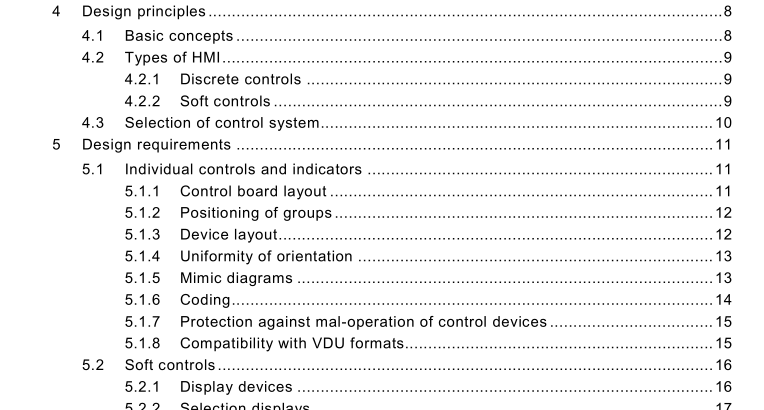IEC 61227:2008 pdf download – Nuclear power plants – Control rooms – Operator controls
Any system shall give immediate feedback to the operator that it has received a control command, for example, by lighting a device or a mark on a VDU. Appropriate plant feedback shall indicate when the command has been implemented, for example the valve has closed.
4.2 Types of HMI The types of operator interface available for control may be classified into two groups,
a) discrete controls comprising dedicated systems / multiplexed conventional systems;
b) soft controls. The groups have the following characteristics, and the task analysis described in 4.3 is used to determine the most appropriate type to use.
4.2.1 Discrete controls Dedicated controls have the disadvantage of being present even when not wanted, thus increasing the size of the whole control desk and providing “clutter” when other controls are in use. Dedicated controls are particularly suitable for controls in constant use, for example electrical output, or those whose immediate accessibility and reliability are of prime importance, for example an emergency trip button. Requirements for their layout are described in 5.1 .1 . Multiplexed controls, a sub-set of discrete controls, use a single control for the same function on several equipments, thus reducing the number of controls on the desk or panel so that they can be made smaller and the controls can be brought closer to the operator. However, the operator has to make a selection, so the number of operations is increased and the chances of error and the operator response time may be increased. Multiplexed controls shall be designed with good feedback to the operator for the function selected, to permit error recovery. They are particularly suitable for the control of seldom- used systems that are not required in a hurry, for example, tank filling, and for systems where the consequences of error are not serious and where time is available for correction in the event of error.
4.2.2 Soft controls These controls are a type of multiplexed system where they can have different functions at different times. Typically, soft controls are implemented using one (or two) VDUs together with a pointing device (such as mouse, track ball light pen or touch capability), or a combination of a VDU with a set of dedicated controls. Control actions are performed in the following way:
– selection of the object to be controlled using the pointing device;
– presentation of the command options on the VDU as menu items or icons, e.g. in a pop- up-window or on a separate VDU;
– selection and activation of the command option to be executed, again using the pointing device. These systems have many of the characteristics of conventional multiplexed systems, but make it possible to assemble controls related to specific tasks and not offer the operator controls that are invalid or inappropriate to that task, so guiding the operator to correct
actions. All information required by the operator to perform the correct control action shall be presented to him when required, either on the touch screen or on a related adjacent format. Selection error rates could be high if the system is not well-designed and, as a hierarchical selection of several formats may be required to recall the control set required, the process of selection of a control not already on display may be relatively lengthy. However, it may be possible to use a single format with changed windows for several control actions.
It is often difficult to optimise the position of the VDU for both monitoring and touching and two screens may be required. Off-screen pointing devices (e.g. track ball and light pen) are an alternative solution.IEC 61227 pdf download.
